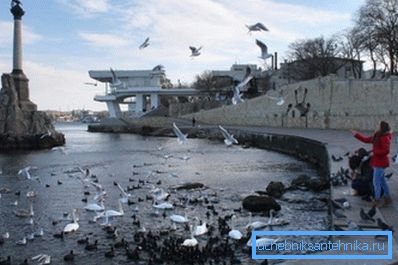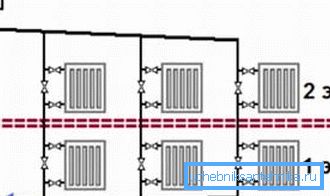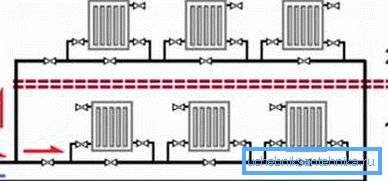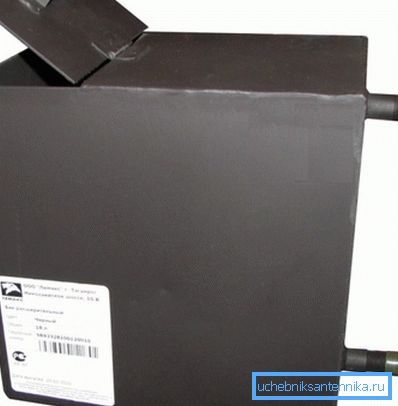The project of heating a two-story house: calculation and
What could be the heating in a 2-storey house? How to dilute the coolant, what heating devices to use? How to calculate the heat output of the boiler, and which boiler should you prefer? The article does not claim to the truth in the last resort: it only expresses the point of view of the author on these problems.

Calculations
How is the water heating scheme of a private 2-storey house calculated?
- 60 watts of heat per cubic meter of volume are taken as the base value of thermal power.
- 100 watts of heat are added to each window in the outer wall, 200 to each door.
- Depending on the climate zone, a regional coefficient is selected:
| Region | Thermal power multiplier |
| Crimea, Krasnodar region | 0.7 - 0.9 |
| Moscow and Leningrad regions | 1.2 - 1.3 |
| Siberia, the Far East | 1.5 - 1.6 |
| Chukotka, Yakutia | 2.0 |
Thus, the heating of a 2-storey building with a floor area of 70 meters, a ceiling height of 3 meters, 8 windows and 3 doors, located in Sevastopol, can be calculated as follows:
- The volume of the room is (70 * 3) * 2 = 420 m3.
- The basic heat output is 420 * 60 = 25200 watts.
- Windows and doors will make their own adjustments: 25200+ (8 * 100) + (3 * 200) = 26600 watts.
- The warm climate of the Crimea will reduce power requirements: 26600 * 0.7 = 18620 watts.

The power of radiators for individual rooms is calculated in the same way.
Nuance: do not forget about the area of rooms without heating appliances. If the hallway warms up due to the batteries in the adjacent room, this battery should be selected according to the total volume of both rooms.
How to count kilowatts in the number of battery sections? It is enough to divide the calculated power of the device into the power of one section, which is always indicated in the accompanying documentation. In its absence, you can focus on the following values:
| Type of sectional radiator | Heat flow corresponding to one section |
| Cast iron | 140-160 |
| Bimetallic | 180 |
| Aluminum | 200 |
Layout
What should be the heating scheme of a 2-storey building - distributing the heat carrier and connecting the heating devices? Here are two of the most simple and affordable solutions.
Standing with top filling
The coolant rises from the boiler into the filing located in the attic, and returns to the return pipeline through the risers with heating appliances. The scheme is attractive, among other things, because it allows to organize heating of a 2-storey house with natural circulation: with a floor area of up to 50 m2, it will work stably without a circulation pump.

Double Leningradka
Leningrad, or a barrack type system, is even simpler and more fault tolerant. In general, it is a ring between the supply and return pipes of the boiler, in parallel with which the radiators of the heating system are connected.
In relation to our situation, the heating scheme of a 2-storey building will include two rings. Three extra meters of bottling on the second floor will not change the temperature of radiators any significant; however, if you wish, you can be puzzled by balancing the rings by installing a disconnecting lower ring choke.

Connecting radiators
Radiators of small length (up to 6-7 sections) are connected quite traditionally - both liners are located on one side.
But with a greater length, one of two alternative schemes is used:
- Diagonal - when the flow and return flow are brought to the right and to the left, to the lower and upper threads.
- Bottom down - when two lower threads are used to connect.
In both cases, it is more convenient to use plug-in plugs, and American women use quick-release couplings with a cap nut.

Materials
What is better to build heating with your own hands? Let's go through its main elements.
Boiler
If your house is gasified, the best option in terms of the cost of heating is a gas boiler. Desirable - condensation: the use of the total heat of combustion of gas (including energy that is taken from the combustion products during their condensation) increases its efficiency by 9-11%.
Security
In a closed system, it is responsible for the so-called security group - automatic air vent, safety valve and pressure gauge. In addition to them, the circuit is completed with an expansion tank, compensating for an increase in the volume of the coolant during expansion. Its volume is taken approximately equal to 1/10 of the total amount of coolant.
Useful: the volume of coolant in a balanced system is usually assumed to be 15 liters per 1 kW-hour of boiler power.
In an open system (most often, a gravity-fed heating system of a 2-storey building is made) the functions of all the above devices are assigned to an open expansion tank. It is mounted on the second floor ceiling or in the attic. The bottoms are laid with a constant slope, so that the air from them is forced out by the coolant into the tank.

Heating appliances
If you use the heating scheme of a 2-storey building with a solid fuel boiler, cast-iron sectional radiators or registers are preferable. Their large mass and large internal volume mean that after the fuel burns out the circuit will cool down rather slowly.
In all other cases, the best choice is aluminum sectional radiators.
What is the reason for the instruction?
- They have excellent heat dissipation.
- Their appearance will fit into the most sophisticated design of the living room.
- Finally, the price - from 280 rubles per section - does not seem ruinous to the most economical homeowner.
Pipes
The typical temperature range for autonomous heating is 50-75 ° C with a pressure of no more than 2.5 atmospheres.
From here and recommendations on the choice of pipes for heating:
- Reinforced polypropylene. Reinforcement will significantly reduce the thermal expansion of the material.

- Crosslinked polyethylene.
- Metal-plastic. Better - with press-fittings: compression is very sensitive to the quality of calibration and at the slightest violation of technology in a few months they begin to flow through the connections.
Conclusion
We hope that our recommendations will help the reader in the design and construction of their own heating. As usual, in the attached video you can find additional thematic information. Successes!